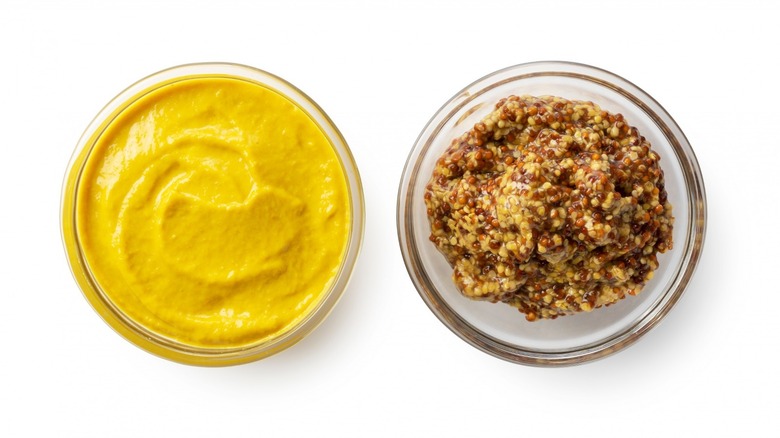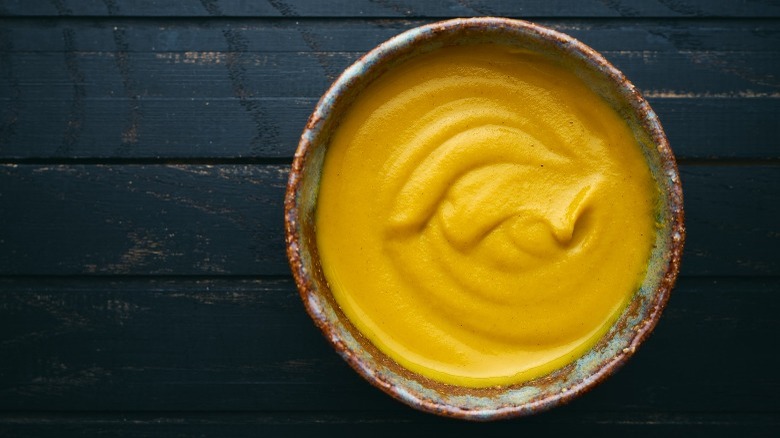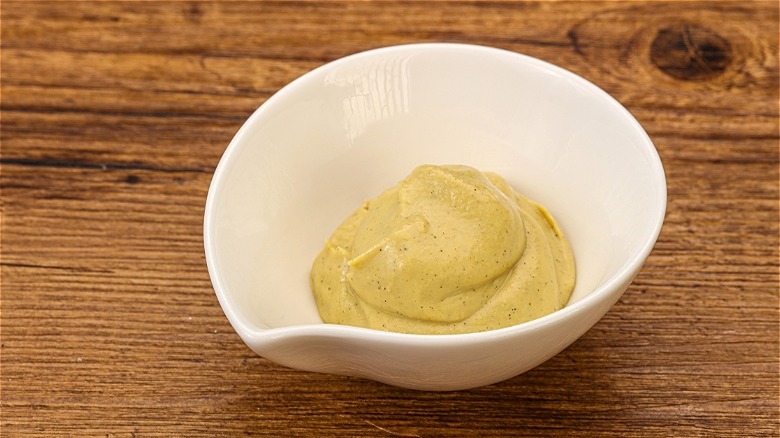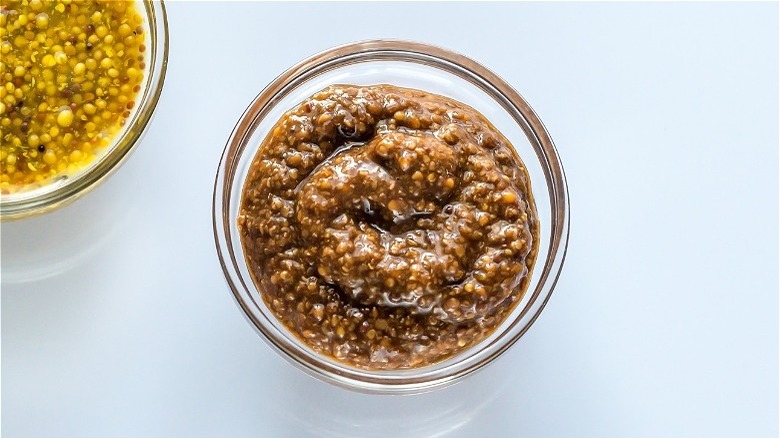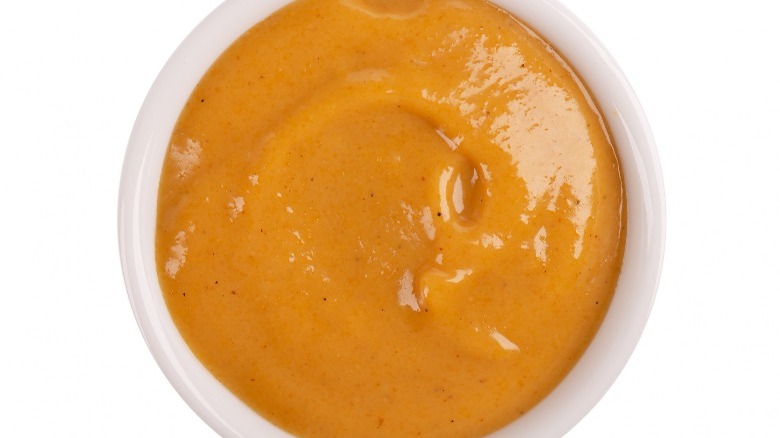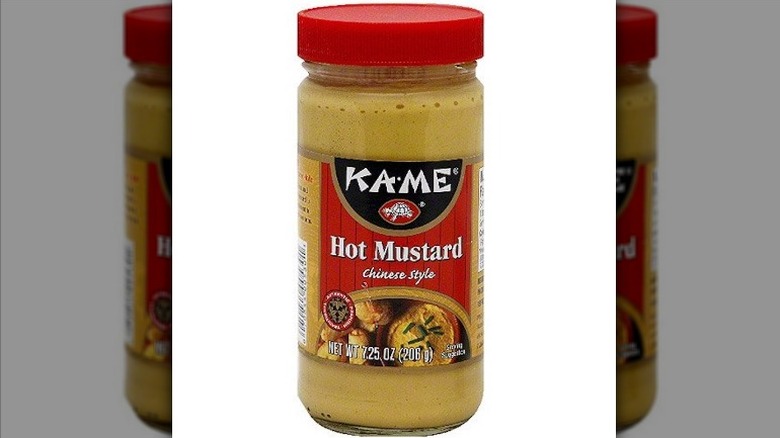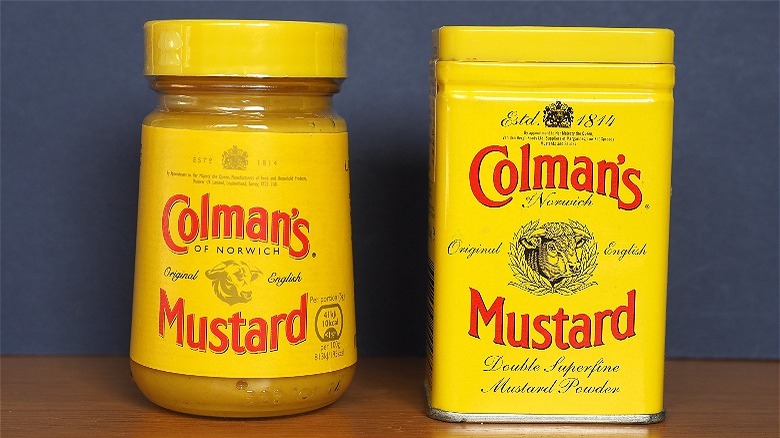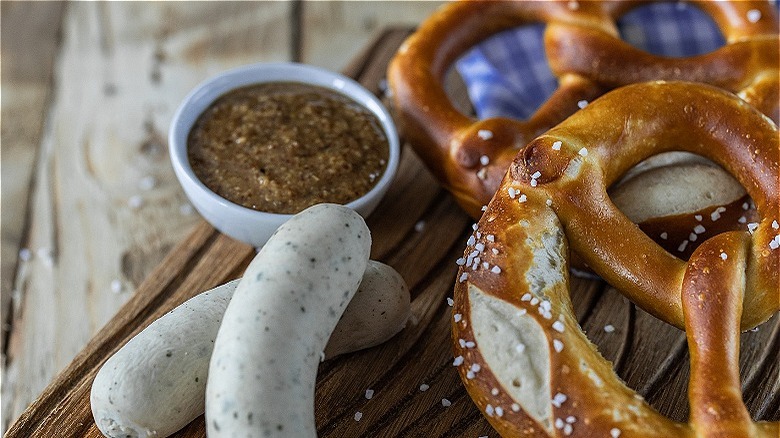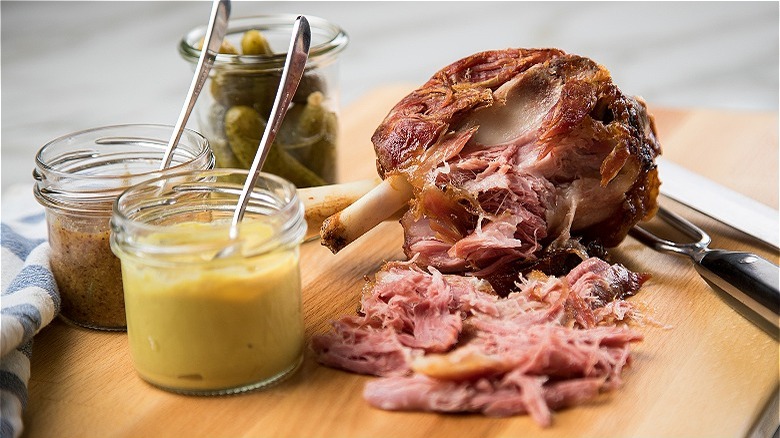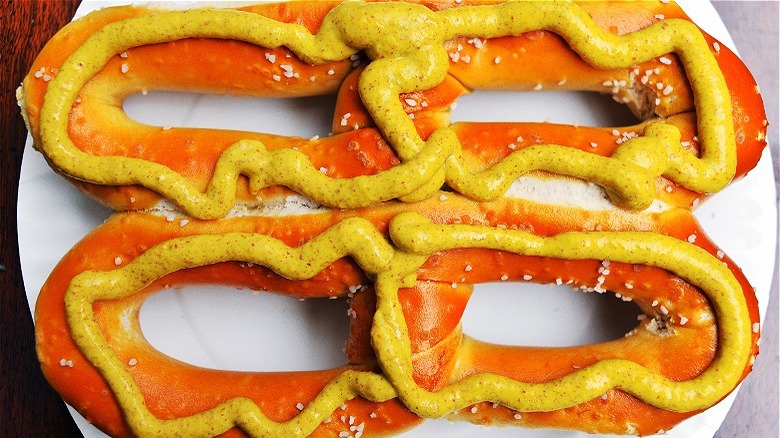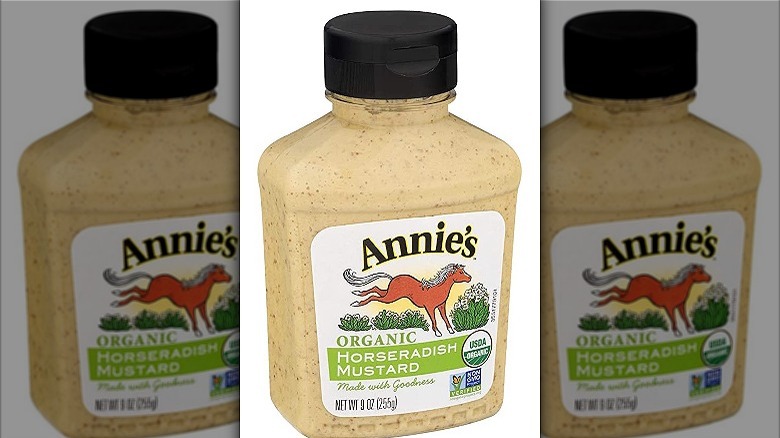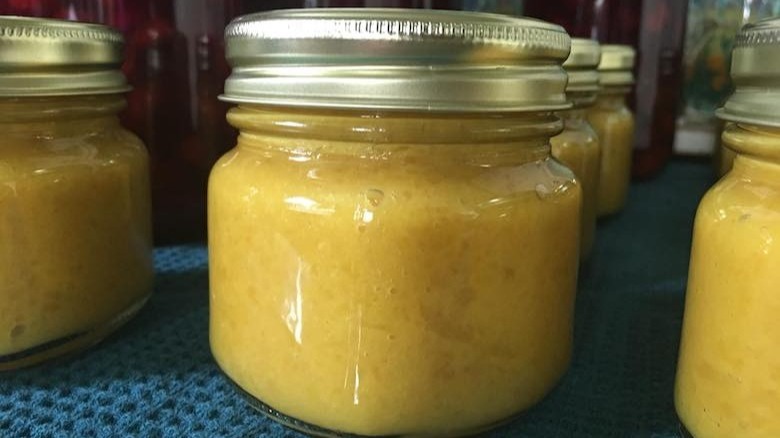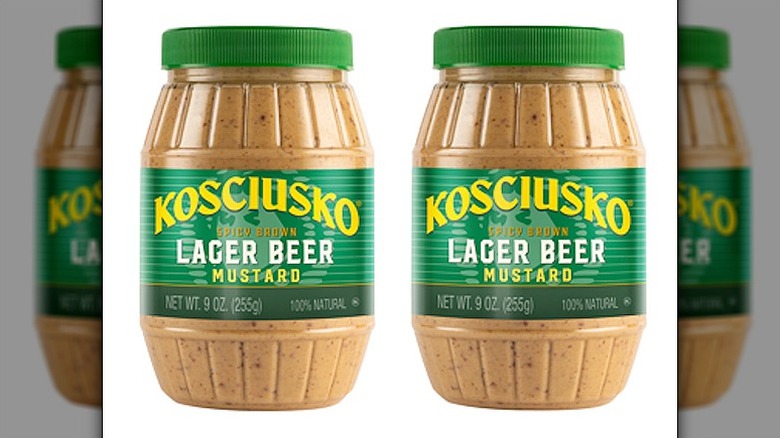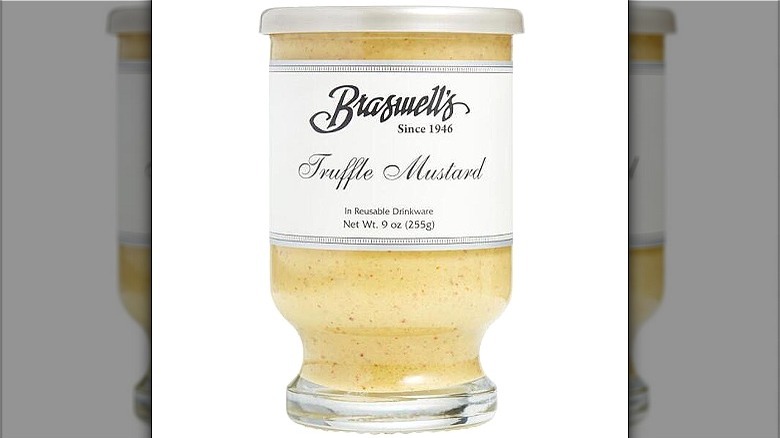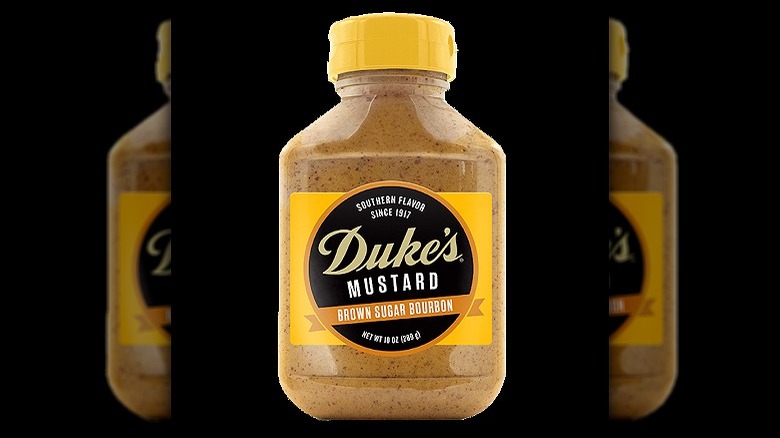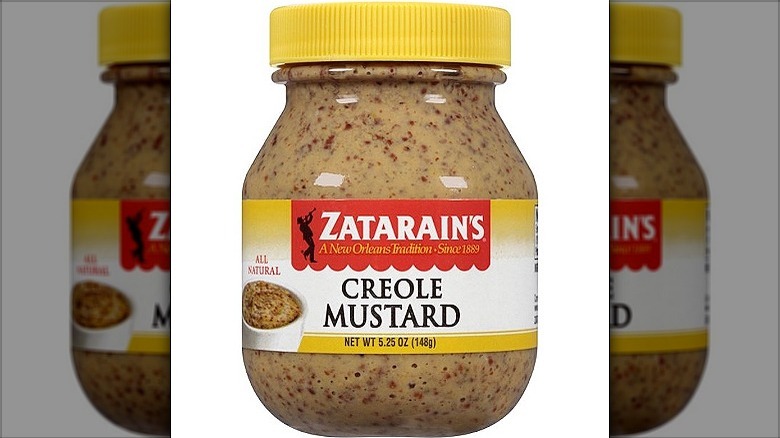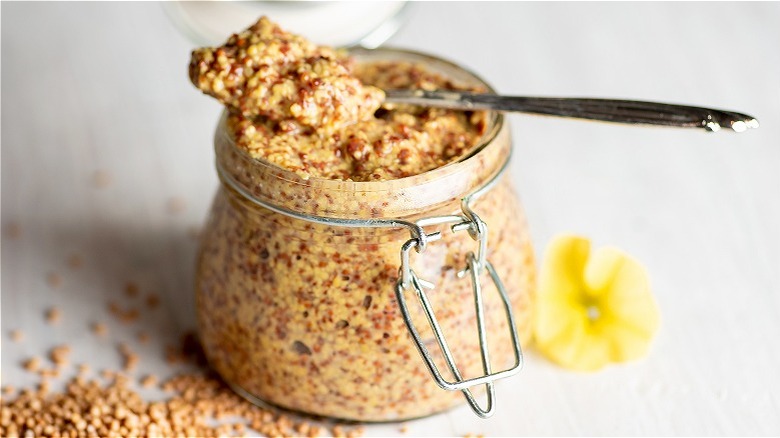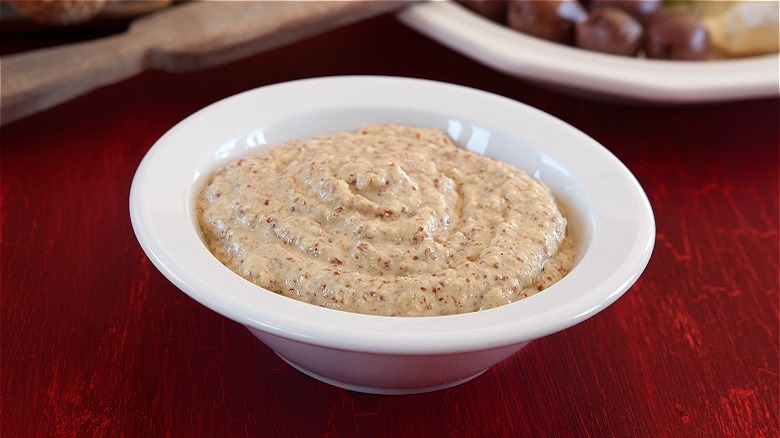17 Types Of Mustard And When To Use Them
There's so much more to mustard than the half-used squeezy bottle you may have in your fridge. Culinary uses of this condiment date back to ancient times: Thousands of years ago, Romans used the condiment in cooking and recipes. Mustard is also popularly used in French cooking. Chinese and Indian cultures have their own methods of integrating mustard seeds into cooking.
Mustard seeds originate from the Sinapis alba plant, which produces white or yellow mustard seeds; the Brassica juncea plant, which produces brown mustard seeds; and the Brassica nigra plant, which yields black mustard seeds. Brown and black seeds generally yield spicier and stronger-tasting mustards than their counterparts.
Making mustard entails soaking seeds in liquid overnight. The spiciness of the mustard is dependent on the kind of liquid that is used, whether it's vinegar, water, or different alcoholic beverages. The extent to which the seeds are blended or ground will also determine a mustard's heat level.
Simple variations within mustard recipes have led to some of the most recognizable types of mustard such as Dijon, spicy brown, and honey varieties. Other creative inventions have entailed the creative addition of ingredients such as horseradish, truffles, or peppers to make new types of mustard. All these different kinds of mustard have contributed to the creative flair and food flavors present at barbecues, beer festivals, Chinese food restaurants, delis, and other settings.
Yellow
Yellow mustard is a bright-colored condiment that is commonly used in the U.S. It is referred to as "American Mustard" and was introduced by brothers George and Francis French at the turn of the 20th century, in Rochester, New York (via the Democrat and Chronicle).
The condiment was first served on hot dogs at the World's Fair in 1904. The French brothers' invention, along with a similar yellow mustard made by Heinz, quickly went on to become two of America's most iconic mustard brands. Today, the two companies are still some of the largest producers of yellow mustard in the United States (via Zippia).
The yellow color distinguishes this mustard from other types of mustard. This yellow coloring is derived from turmeric, which is the main ingredient that is used to dye yellow mustard (via Today I Found Out). Heinz and French brand mustards both contain turmeric.
Yellow mustard is commonly made from white mustard seeds (via Alpha Foodie). According to Great British Chefs, these seeds are milder in taste than other seeds. To make yellow mustard, these seeds are ground up and then mixed with ingredients like vinegar, water, salt, paprika, garlic, and other spices are added. The result is a smooth and somewhat mild condiment that livens and adds color to classic American recipes like hot dogs, hamburgers, and potato salad.
Dijon
The Grey Poupon company was once the primary producer of Dijon mustard (via Regions of France). This mustard variety originated in France as early as the 1300s. The name "Dijon" refers to the capital city of the Burgundy region of France, which is known for its wine.
The original recipe for Dijon mustard was created in Dijon. Today, this mustard can be made anywhere, per Rare Seeds, but the formula is still inspired by the French one. Dijon mustard has a lighter yellow coloring than yellow mustard due to the absence of turmeric.
It is usually made with brown and black mustard seeds (via the Foodies Family). Originally recipes for dijon mustard recipes contained verjus or verjuice, which is a sour liquid that is extracted from unripe grapes. According to Simply Recipes, a combination of other ingredients like white wine and vinegar usually replace verjuice in most mustard recipes today.
Dijon mustard is known for being more acidic and intense in flavor than yellow mustard. However, as one Quora user explains, Dijon mustard tastes less vinegary than its American counterpart. It's is also available in coarsely ground varieties, which gives the condiment a grainer texture. This mustard is most commonly used to make salad dressings such as French vinaigrettes. According to The Culture Trip, this condiment is also used in French meat recipes
Spicy brown
As the name suggests, spicy brown mustard is brown in color and is spicier than Dijon or yellow mustard varieties. According to SPICEography, spicy mustards began with a German condiment called Düsseldorf mustard. Spicy brown mustard is descended from Düsseldorf and it became popular with Americans during the second half of the 19th century.
Gulden's spicy brown mustard has received recognition for its incredible taste. Charles Gulden established his mustard company in 1862 in New York; the brand has been selling different kinds of mustards ever since. Brown mustard seeds are used to create spicy brown mustard, which gives this condiment its spicy flavor and brown coloring (via Food Champs). The process for making this mustard uses less vinegar than some other types of mustard to enhance the overall heat levels. This also tempers the overall acidity of the mustard, which further increases the spice levels.
Spicy brown mustard also contains other ingredients such as salt, water, and various spices. Heinz's version uses turmeric, onion powder, and garlic powder. Due to its powerful, intense, and spicy flavor profile, this mustard is often used as a topping rather than a cooking ingredient, which allows the amount of spice to be easily controlled. Primal Kitchen recommends using it as a spread for sandwiches and sausages.
Honey
The origins of honey mustard are as ancient as mustard itself: According to SPICEography, a Roman cookbook from around the 4th or 5th century included an infamous recipe for a mustard-like sauce that featured honey. Today, honey mustard has become a mainstay of different dishes: Notably, it's an important component of Chick-fil-A's eponymous sauce that became popular in the 1980s.
Honey mustard is usually made with yellow mustard seeds (Simply Recipes). This creates a milder flavor which really allows the sweetness of the honey to shine. Brown mustard seeds are often mixed with yellow seeds to make a sharper-tasting version of honey mustard. Other common ingredients in honey mustard include water, vinegar, sugar, salt, and spices (via Healing and Eating).
As Delighted Cooking explains, this condiment is often used as a stand-alone component in various recipes. Unmixed honey mustard can be used as a dip for snacks like soft pretzels, fries, or onion rings. It's commonly used in various American chicken dishes, such as fried chicken, wings, or nuggets. It can also be used in salad dressings and marinades for lighter dishes.
Chinese hot
According to SPICEography, in China, it was initially more common to consume the greens of the mustard plant rather than the seeds. Eventually, mustard seeds came to be used for culinary as well as medicinal purposes, with mustard seeds being pickled and turned into oil. Today, it is often served at Chinese restaurants as a dipping sauce alongside certain dishes.
Chinese hot mustard isn't called "hot" for nothing: It possesses a spicy hot flavor that is often derived from the addition of white pepper (via Allrecipes). According to Greatist, white pepper contains more heat than black pepper. Additionally, Chinese hot mustard is usually made with brown mustard seeds, further adding to the overall intense flavor.
Some recipes for this type of mustard don't use vinegar. Instead, crushed mustard seeds are mixed with water. This substitution eliminates a common acidic ingredient that usually balances the heat within mustards.
As Woks of Life explains, you've likely encountered this mustard at Chinese restaurants in the United States, inside those small, translucent packages placed within your takeout boxes, or next to a plate of fried appetizers. Chinese hot mustard's spicy flavor goes very well with all kinds of shareable, savory Chinese dishes like spring rolls, crunchy fried noodles, as well as egg rolls, and fried wontons (via HEB).
English
English mustard is a condiment that is popular in the United Kingdom. It has a medium yellow color and is somewhat spicy. According to Our Everyday Life, English mustard is typically spicier than spicy brown mustard but not as spicy as Chinese hot mustard. This mustard is traditionally made from yellow mustard seeds or a mixture of different seeds.
Colman's is an iconic English mustard company. The yellow packaging of Colman's products is commonly associated with English mustard. English mustards are also available as a dry powder. Colman's powder only contains "mustard flour": According to My Spice Sage, this term usually refers to ground mustard seeds. Colman's also sells a prepared English mustard that is thicker in texture due to the addition of wheat flour, which acts as a thickening agent.
English mustard is used in classic British recipes: It is often used in Sunday roast, a dish that singer Adele allegedly does every Sunday. Sunday roast recipes, such as this rendition of slow-cooker roast beef, typically use English mustard powder as a seasoning. Other British recipes that work well with prepared English mustard include cheese toasties and Yorkshire pudding (via Prima).
Bavarian sweet
Bavarian sweet, or Bavarian mustard, is a type of German mustard that is often served at Oktoberfest. Oktoberfest is an annual beer and food festival that is traditionally held in Munich, the capital of Bavaria, Germany. According to Develey, Johann Conrad Develey is credited with inventing this sweet condiment in 1854.
Although it's not the only type of mustard you'll find at Oktoberfest and similar events, it's easy to spot. This condiment is coarsely ground, which gives it a darker, multicolored appearance (via Daring Gourmet). Bavarian sweet mustard is usually sweeter, milder, and less spicy in flavor than other German mustard varieties such as Düsseldorf and Mittelscharf (via German Foods).
This mustard is traditionally served with German Oktoberfest dishes like Leberkäse, a blend of pork and beef cuts shaped into a loaf, Käse Krainer, a thick sausage filled with cheese, and Weisswurst, sausage made from veal and pork. Of course, as World Market points out, it also goes well with pretzels. However, Bavarian sweet mustard can also be used in American cuisine.
You can also spread Bavarian sweet mustard on savory sandwiches that contain grilled cheese, roast beef, or pastrami (via September Farm Cheese). Since it's not too spicy or intense, you can also mix this mustard with other ingredients to make a salad dressing.
Mittelscharf
According to Yummy Bazaar, in Germany, the popularity of mustard has led to the emergence of several different kinds of mustard. "Mittelscharf" refers to most German mustards which contain a medium amount of heat. Medium mustards are among the most popular mustards in Germany. Thomy, a German company, is well known for its medium mustard: This mustard is even sold in the U.S. by stores like World Market.
Mittelscharf mustards are usually made with both brown and yellow seeds. They have a little kick but the flavor is far from overly intense. The consistency of medium German mustards is typically quite smooth. According to German Foods, there are three types of mustard available in Germany: The word "senf" will indicate a type of mustard that is similar in consistency to the types of mustard found in the U.S. such as Dijon, yellow, Chinese hot, or honey. "Senfkörner" refers to a whole grain style of mustard while "senfpulver" refers to dry mustard powder.
Mittelscharf mustards are generally senf style: If you're looking for this kind of mustard, stick to brands such as Thomy. The Löwensenf brand makes a medium-hot mustard which is commonly used for a variety of German recipes, including as a dipping sauce for various meats (via Lobels). Since it's the middle-of-the-road in terms of spice, you can mix it into various dressings or marinades for a subtle but delicious flavor.
Düsseldorf
Düsseldorf, also known as ABB is another type of German mustard (via Taste Atlas). Like Dijon, the name Düsseldorf refers to the city where the mustard originated. According to Cooks Info, the German city is home to the country's first mustard factory, which opened in the 18th century. As Forbes explains, Düsseldorf mustard, similar to Dijon mustard, has gained a reputation in Europe as a great-tasting condiment.
Sweet-and-sour is the iconic variety of Düsseldorf mustard. According to Chicago Tribune, some experts specify that Düsseldorf is made from both yellow and brown mustard seeds and that it must contain a few special ingredients only found in the German city, like local unfiltered spirit vinegar and water. Traditionally, Düsseldorf mustard is especially spicy. It's spicier than Mittelscharf or Bavarian sweet mustards.
This mustard is used in many recipes in German cooking, as well as regionally in the city of Düsseldorf and surrounding areas. For Travel Advice Lovers explains that you can use this mustard to make dishes like Halve Hahn, a type of open-faced cheese sandwich with mustard. You can also mix Düsseldorf with other ingredients to prepare salads, cooked vegetables, meat dishes, and more. If you're new to this type of mustard then just remember that Düsseldorf mustard can be quite intense (via Wine4Food).
Horseradish
Horseradish is a plant root that contains a hot and flavorful kick and makes for a great mustard that packs a truly powerful punch. This root vegetable is said to have certain health benefits (via WebMD). According to Healthline, the burning feeling in your throat, sinuses, and nose that is caused by ingesting horseradish may act as an antibiotic.
Typical recipes for horseradish mustard generally use brown mustard seeds (via Better Hens and Gardens). Other ingredients for horseradish mustard include vinegar (typically white distilled or apple cider vinegar), horseradish root, salt, garlic, and other spices. Sometimes, a sweetener such as cane sugar or honey is also added (via Stonewall Kitchen). Horseradish mustard is quite spicy and has a unique kick to it in terms of both flavor and heat.
You can use horseradish mustard when preparing food for those that like a bit of spice. You can also use this condiment for the marinade of a prime rib roast, as a topping sauce for meat and burgers, or even inside of deviled eggs (via Yummly). Of course, this mustard should be used with caution, as it can be especially overpowering although this is also what makes it great for adding a pinch of nose-clearing heat to your homemade sandwich.
Banana pepper
This condiment contains banana peppers. You may not be familiar with this exact kind of mustard though you've probably encountered banana peppers, which are a type of pepper that are commonly added to pizzas, in Greek salads, or on sandwiches like cheesesteaks or hoagies. The peppers are known for their larger size and bright yellow color.
As Chili Pepper Madness explains, these peppers are especially mild and rank at the bottom of the Scoville scale with a score of only 500 units. While these peppers have a mild bite and little spice, combining these peppers with spicy mustard seeds tends to really elevate the heat levels. Miller's brand banana pepper mustard is fairly spicy and contains other ingredients that are commonly used in mustard, such as vinegar, sugar, salt, turmeric, and paprika.
This type of mustard can be used in American food as well as other cuisines. In general, banana pepper mustard is spicier than other mustards and so should be used in moderation. Cherchies makes an award-winning hot banana pepper mustard which can be used in sandwiches, hot dogs, and sausages. This mustard also makes for an incredible addition to charcuterie boards.
Beer
As the name indicates, beer mustard is simply mustard that's made with beer. According to Spice Jungle, this condiment essentially consists of coarse mustard and flat ale. A flat ale is a beer without any bubbles or carbonation (via Bloomberg).
Spices Inc. explains that beer mustard is made a little differently than other mustards. Instead of soaking mustard seeds in vinegar, they are soaked in beer and vinegar. Spices Inc. uses a porter style of beer to make beer mustard. The result is a mustard that is spicier and less acidic in flavor.
Another beer mustard made by Tin Mustard soaks its mustard seeds in vinegar. However, that vinegar is first fermented with amber beer. Historic American mustard company Plouchman's has been around since the 1850s and also makes a wonderful beer mustard. The brand uses an American pale ale to make this mustard.
Zingerman's recommends using the Kleinhettestedt beer mustard with traditional Eastern European recipes including bratwurst. Dilly Dally Provisions recommends using its beer mustard for grilled or smoked meat dishes such as brisket, whole smoked chicken, or bratwurst. Even though the beer may be dulling down the overall taste of mustard, some varieties of beer mustard will still contain a kick. The best way to gauge the spice level of the beer mustard you pick up is to sample your chosen condiment before slathering it on any of your creations.
Truffle
Truffle mustards are a great option for lovers of truffle. Truffles are an expensive, edible fungi that are available in three different varieties: Black, white, and burgundy (via Eataly). The black ones typically taste robust, the white ones taste like shallots, and burgundy truffles are more delicate in flavor. Truffles generally taste earthy and nutty with a bit of a mushroom flavor (via BBC Good Food). The tasting notes within truffle mustard will vary depending on which kind of truffles are used.
Recipes for these mustards may use a combination of yellow and brown mustard seeds (via Eat Smarter). The texture may fluctuate, based on the extent to which the mixture is blended. Truffles may be added to truffle mustard in various different forms including truffle oil, truffle butter, and truffles themselves, or some combination of the three. These mustards tend to taste creamier than other mustards, allowing you to enjoy the truffle flavor without interference from excessive spice or sweetness.
Truffles are an important part of French cuisine and black truffles grow naturally in the wild in France, so it's no surprise that two of the most beloved French mustard brands have utilized the ingredient: Both Maille and Pommery sell black truffle mustards. These products are ideal for incorporating into French cooking, as well as other cuisines. Maille recommends using truffle mustard for scrambled eggs, T-bone steaks, as well as macaroni and cheese.
Bourbon
This mustard contains bourbon, which is a type of American whiskey that originated in the United States. Popular American condiment companies, such as Plochman's and French's sell bourbon mustard. Chicago-founded company Plochman's product is made from a combination of aged bourbon and spicy brown mustard. French's product is a stone ground-style mustard that contains bourbon and brown sugar.
Some recipes for bourbon mustard require only brown mustard seeds (via Cooking with Mary and Friends). Using these seeds will result in hotter kinds of mustard. However, since the process for making bourbon mustard generally entails soaking seeds in bourbon and the addition of sugar, the sweetness tends to dull the heat, resulting in a mustard that is less spicy than other varieties.
Stonewall Kitchen describes its bourbon molasses mustard as a combination of the cuisines of the American South and the Northeast. Because of these different ties, the company recommends using bourbon mustard on anything from potato salad to baked beans. The typical sweetness of this mustard also makes it ideal for glazing meats such as salmon or ham (via Duke's Mayonnaise).
Creole
According to Taste Atlas, you may come across Creole mustard in the American South. This type of mustard combines coarsely ground brown mustard seeds, spices, and horseradish. Creole seasoning is typically added to this condiment. According to Daring Gourmet, Creole seasoning contains ingredients like paprika, cayenne, thyme, garlic, onion, smoked paprika, salt, pepper, and basil. This spice blend is often confused with Cajun seasoning. Although the two are similar, Creole seasoning tends to be more herbal and less spicy than Cajun seasoning.
According to Nola Cuisine, traditional recipes for Creole mustard typically entail soaking mustard seeds in distilled vinegar, coarsely grinding them, and letting the mixture marinate for about 12 hours. This mixture is then combined with seasoning, and the resulting mustard is spicier than types of mustard such as Dijon, yellow, or honey. However, Creole mustard tends to be more uniquely savory and flavorful than most other mustard types.
This type of mustard lends itself to the type of cuisines from which it originates. The condiment pairs well with iconic recipes from New Orleans, Louisiana, which is well known for Creole cooking. According to SPICEography, Creole mustard is an essential ingredient in a New Orleans-style remoulade sauce or a po'boy sandwich.
Whole grain
Whole grain mustard is a condiment in which mustard seeds are either ground very slightly or not ground at all (via SPICEography). This condiment usually appears as a grainy, multi-colored mixture. The different colors in whole grain mustard arise from the mixture of whole yellow and brown mustard seeds. Since the shape of the seeds is generally preserved, the texture is wonderfully layered and toothsome. Each spoonful of this mustard is filled with different spheres of seeds rather than the smooth texture of many other mustard types.
Whole grain mustard is a more natural and unprocessed mustard variety; additionally, it is also supposed to have some health benefits: According to Catsup and Mustard, mustard contains different vitamins and minerals and a variety of wellness-boosting benefits: Mustard seeds contain magnesium, which may improve sleep quality; calcium, which helps with bone strength, as well as selenium, which assists with fighting allergies.
This mustard also has a unique flavor. According to Healthy Food, whole grain mustard tends to be less spicy than other mustards. The mild flavor of this mustard is due to the seeds not being ground, as this prevents the dispersion of the flavor from the seeds.
However, the seeds themselves contain a bit of spice, so these mustards are not without a little heat. According to Spoon Fork Bacon, the mild flavor of whole grain mustard makes it a versatile addition to cheese or charcuterie boards since these may involve multiple people with different spice tolerances sharing one dish.
Stone ground
Stone ground mustard is a term that references the old method of making mustard which involved the use of a stone mill to grind the mixture (via Recipe Tips). This process entails putting the mustard seeds into a device called a quern that has two stacked millstones. According to SPICEography, the resulting texture was usually a mix of partly ground, fully ground, as well as fully intact mustard seeds.
However, due to the outdated nature of the devices used to create this mustard, stone ground mustard varieties are less common today. Raye's Mustard Mill Museum in Eastport, Maine, claims to own America's last authentic stone-ground mustard mill.
Today, companies will refer to products that are similar to stone-ground mustard by different names: Terms such as "old-style" or "country" are used to refer to barely ground mustard, that's blended slightly more than whole grain mustard.
The famous French mustard company "Maille," founded by Antoine-Claud Maille in 1747, is one of the most esteemed and historical producers of mustard. Maille produces a Maille à l'Ancienne Old Style mustard that has a wonderfully grainy texture. Inglehoffer recommends pairing its stone ground mustard with prime rib, rustic sandwiches, and salad dressings.
